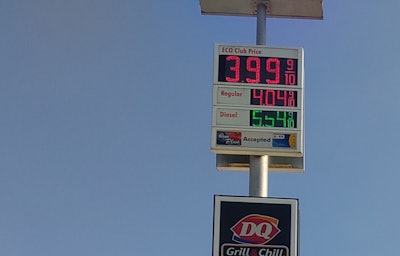It’s official -- well, it’s been official for a good while now -- fuel is absolutely out of hand! Spot market rates for vans and reefers have been sinking, and big carriers nonetheless seem bullish on long-term prospects, for once in the last couple of years. These years have been a boon by and large for small carriers, even with COVID-inspired difficulties.
Market-to-market, though, there are plenty of freight and rate have-and-have-not dynamics to go around.
An object lesson came via a conversation this week with owner-operator Mike “Mustang” Crawford. The owner-operator, whose Mustang’s Trucking business reached the 4 million safe miles mark above the frame of a single truck last week, told the story of a roundtrip with intracompany picks and drops at the same facilities on either end of the lane between Harvey, Illinois, and Phoenix. From Harvey, the all-in rate (with a fuel surcharge on a contract load) was more than $6,000, on 1,700 miles of hauling, with a flatbed.
The next run, coming straight back to Harvey from the same place he'd just delivered to in Phoenix, was priced just a couple hundred dollars more than $3,000 for the same 1700-some loaded miles.
The difference? The market the freight's coming out of, foregrounding the importance of freight choosiness for owner-operators as markets loosen up from historically high levels of tightness experienced in the last year.

 Spotted in Crossville, Tennessee, on the way to the Large Cars & Guitars truck-show event ongoing in Kodak, Tennessee, through Saturday -- the five in the dollar column looks like it's been getting a workout of late. ...
Spotted in Crossville, Tennessee, on the way to the Large Cars & Guitars truck-show event ongoing in Kodak, Tennessee, through Saturday -- the five in the dollar column looks like it's been getting a workout of late. ...
Phoenix is a place Crawford notes has always been problematic for good rates on flatbed loads -- flatbed spot rate averages, according to DAT analytics, outbound from Phoenix to markets in Missouri and Indiana in the last week were well less than even the van averages, for instance, at around about $2.30 and a $1.90 respectively. Crawford got close to the average outbound with a healthy 79-cent-a-mile fuel surcharge built into the rate both inbound and outbound from Phoenix and covering $4.70 worth of every gallon burned.
 Overdrive's Small Fleet Champ program for 2022, sponsored by the National Association of Small Trucking Companies, is open for entries now. Enter your business via this link.
Overdrive's Small Fleet Champ program for 2022, sponsored by the National Association of Small Trucking Companies, is open for entries now. Enter your business via this link.
Furthermore, what a company like his sees in times of relatively weakening spot market demand is brokers and 3PLs pitching the businesses small fleets contract with for much of their freight on the ability to lock in a lower rate via access to spot market capacity.
Today on Overdrive Radio, it bears repeating that there’s a strong negotiating tool any truck owner has in the arsenal -– the right of refusal. A smart broker might try to get what he/she can out of the rate, but should also know well what transport providers are paying for fuel and everything else. Consider your own pay as an expense pre-negotiation, and feeling "lucky to break even," as a truck owner relatively new to the business told National Public Radio in a segment that aired this week, isn't going to cut it:
[Related: Diesel prices continue to batter profitability, soaring to new record highs]
As a wise man once said, speaking at the depths of the pandemic, "You will never, ever, come out ahead running at a loss."
Put another way by another wise man around the same time: “Don’t forget the value of your right of refusal -– that’s your line in the sand.”
Also on the podcast: Find more on the fuel market in today's Overdrive Radio from David Owen, manager of the largest OTR diesel account in the nation -- the Quality Plus Network fuel program of the National Association of Small Trucking Companies. More, too, from Jason Cowan of Silver Creek about his dual bulk-delivery and fuel-card strategy for pump price discounts.












